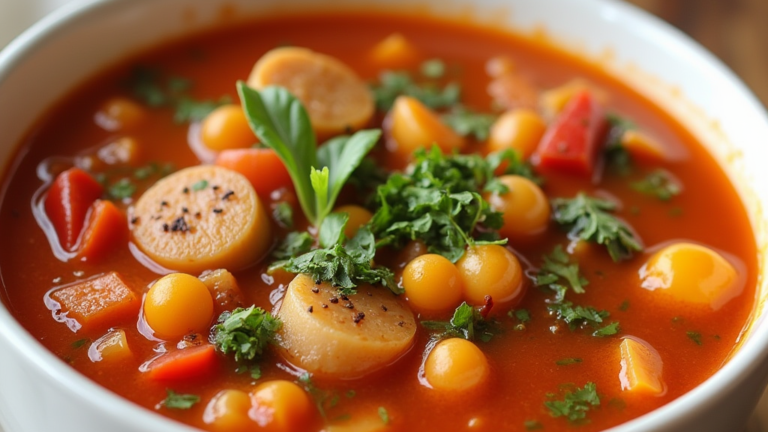Table of Contents
What Is Minestrone Soup?
Minestrone soup is a beloved Italian dish that has gained popularity across the globe for its rich flavors and versatility. Originating in Italy, this hearty soup combines seasonal vegetables, legumes, and pasta or rice in a flavorful broth. Unlike other soups, minestrone soup does not follow a rigid recipe, making it a reflection of the chef’s creativity and the ingredients available.
This soup’s name comes from the Italian word “minestra,” which means “soup” or “stew.” Traditionally, it served as a frugal meal, utilizing leftover vegetables and pantry staples. Over time, minestrone soup evolved into a celebrated dish in Italian cuisine, known for its comforting and wholesome nature.
Key ingredients in minestrone soup include tomatoes, onions, beans, celery, and carrots, though variations abound. The dish is often seasoned with Italian herbs like basil, oregano, and thyme. Whether served as an appetizer or a main course, minestrone soup delights with its robust taste and nutritional value.
ingredients:
Vegetables:
- 2 tablespoons olive oil
- 1 onion, diced
- 2 garlic cloves, minced
- 2 carrots, diced
- 2 celery stalks, diced
- 1 zucchini, diced
- 1 cup green beans, trimmed and cut into 1-inch pieces
- 1 cup spinach or kale leaves
Base:
- 4 cups vegetable broth (or chicken broth)
- 1 can (14 oz) diced tomatoes
- 2 tablespoons tomato paste
Protein and Carbs:
- 1 can (15 oz) cannellini beans, drained and rinsed
- 1/2 cup small pasta (ditalini, elbow, or shells) or rice
Seasonings:
- 1 teaspoon dried basil
- 1 teaspoon dried oregano
- 1/2 teaspoon thyme
- Salt and pepper to taste
Garnish:
- Fresh parsley, chopped (optional)
- Grated Parmesan cheese (optional)
These ingredients make a flavorful and wholesome minestrone soup, adaptable to dietary preferences. Let me know if you’d like suggestions for variations or substitutions!
How to Make it
Crafting traditional minestrone soup involves combining fresh vegetables, savory broth, and pasta or rice to create a harmonious blend of flavors. Follow these steps for an authentic preparation:
- Gather Ingredients: Assemble tomatoes, onions, garlic, celery, carrots, zucchini, green beans, cannellini beans, and spinach. Add vegetable or chicken broth, olive oil, and dried herbs like basil and oregano.
- Prepare Vegetables: Dice all vegetables uniformly to ensure even cooking.
- Sauté the Aromatics: In a large pot, heat olive oil and sauté onions and garlic until fragrant.
- Add Vegetables: Incorporate celery, carrots, and zucchini, stirring occasionally to enhance their natural sweetness.
- Simmer with Broth: Pour in the broth and diced tomatoes, then bring to a gentle boil. Lower the heat and let the mixture simmer.
- Cook Pasta or Rice: Add pasta or rice during the final cooking phase, ensuring it doesn’t overcook.
- Season and Serve: Adjust seasoning with salt and pepper. Garnish with fresh parsley or grated Parmesan cheese for added flavor.
This recipe exemplifies how minestrone soup adapts to seasonal produce, making it an enduring favorite.
What Vegetables Are Typically Used in Minestrone Soup?
Vegetables are the cornerstone of minestrone soup, offering both flavor and nutrition. While the ingredients may vary based on region and season, some vegetables are commonly included:
- Tomatoes: Often used as a base, tomatoes provide a tangy and robust flavor.
- Onions and Garlic: These aromatics add depth to the soup’s flavor profile.
- Carrots and Celery: These staples offer sweetness and crunch, balancing the dish’s overall taste.
- Zucchini and Green Beans: These summer vegetables add freshness and texture.
- Leafy Greens: Spinach or kale enrich the soup with vitamins and a vibrant color.
- Legumes: Beans like cannellini, kidney, or chickpeas add protein and a creamy texture.
By incorporating these vegetables, minestrone soup becomes a wholesome and adaptable dish. Depending on availability, seasonal vegetables such as butternut squash or peas can also be added, enhancing the soup’s appeal.
Can Minestrone Soup Be Made Vegetarian or Vegan?
Absolutely, minestrone soup is inherently flexible and can easily be made vegetarian or vegan. By selecting plant-based ingredients, the dish retains its hearty and satisfying qualities. Here’s how:
- Broth Selection: Use vegetable broth instead of chicken or beef stock.
- Omit Dairy: Skip Parmesan cheese or substitute it with nutritional yeast for a cheesy flavor.
- Add Plant Proteins: Include more legumes like lentils, chickpeas, or tofu for protein.
- Enrich with Healthy Fats: Olive oil and avocado slices can enhance flavor and texture.
These adjustments allow vegetarians and vegans to enjoy a delicious bowl of minestrone soup without compromising its essence. Whether following dietary preferences or accommodating guests, this soup remains a crowd-pleaser.
Is Minestrone Soup Healthy?
Minestrone soup is celebrated for its nutritional benefits, making it a healthy choice for any meal. Here are some reasons why it’s a nutritious option:
- Rich in Vegetables: The variety of vegetables provides essential vitamins, minerals, and fiber.
- Low in Calories: Without heavy creams or excessive fats, this soup is naturally low in calories.
- High in Protein: Beans and legumes contribute plant-based protein, supporting muscle health.
- Heart-Healthy Ingredients: Olive oil and garlic are known for their cardiovascular benefits.
To make minestrone soup even healthier, opt for whole-grain pasta or quinoa and limit added salt. This soup’s balance of carbohydrates, protein, and healthy fats makes it a wholesome choice for any diet.
How to Store and Reheat Minestrone Soup
Proper storage and reheating ensure that your minestrone soup remains delicious for days. Follow these tips:
- Storing: Allow the soup to cool before transferring it to airtight containers. Refrigerate for up to 5 days or freeze for up to 3 months.
- Reheating: Thaw frozen soup in the refrigerator overnight. Warm on the stove over medium heat or in the microwave, stirring occasionally.
- Adjust Texture: Add a splash of water or broth if the soup thickens during storage.
By following these steps, you can enjoy the flavors of minestrone soup even after its initial preparation. It’s an ideal make-ahead meal for busy weeks, offering convenience without sacrificing quality.
What Are Some Variations of Minestrone Soup?
Minestrone soup is a versatile dish with countless variations, making it adaptable to individual preferences and regional influences. Some popular variations include:
- Seasonal Variations: Use summer vegetables like zucchini and tomatoes in warm months, and hearty root vegetables like squash and potatoes during colder seasons.
- Regional Twists: Northern Italian versions may include rice instead of pasta, while southern regions might add spicier seasonings.
- Meat Additions: While traditionally vegetarian, some recipes incorporate pancetta or sausage for added depth of flavor.
- Gluten-Free Options: Substitute pasta with gluten-free alternatives like rice, quinoa, or chickpea pasta.
These variations showcase the adaptability of minestrone soup, ensuring there’s a version to suit every palate and occasion.
Can You Freeze Minestrone Soup?
Yes, minestrone soup freezes exceptionally well, making it a convenient option for meal prepping. Here’s how to do it effectively:
- Cool the Soup: Allow the soup to cool completely before freezing to prevent ice crystals from forming.
- Use Proper Containers: Store in airtight, freezer-safe containers or resealable bags. Leave some space for expansion.
- Portion Wisely: Divide the soup into individual servings for easier reheating.
- Avoid Overcooking Pasta: If freezing, cook pasta separately and add it after reheating to maintain its texture.
Freezing minestrone soup helps retain its flavors and nutritional benefits, making it a practical choice for busy days.
What Pasta Shapes Work Best in Minestrone Soup?
The choice of pasta shape can significantly influence the texture and eating experience of minestrone soup. Here are some excellent options:
- Small Shapes: Ditalini, elbow macaroni, or small shells blend seamlessly with the soup’s vegetables and broth.
- Tubular Pasta: Penne or rigatoni hold sauces and add a hearty bite.
- Gluten-Free Options: Chickpea or rice-based pasta works well for those with dietary restrictions.
Opting for smaller shapes ensures the pasta doesn’t overpower the soup’s delicate balance of ingredients.
How to Add Protein to Minestrone Soup
While minestrone soup is already nutrient-rich, adding extra protein can make it even more satisfying. Consider these options:
- Legumes: Double up on beans like cannellini, kidney, or lentils.
- Meat or Poultry: Add cooked chicken, ground turkey, or Italian sausage for a heartier meal.
- Plant-Based Proteins: Tofu or tempeh are excellent vegan-friendly choices.
- Cheese: A sprinkle of Parmesan or a dollop of ricotta enhances both protein content and flavor.
These additions elevate minestrone soup into a complete and filling meal for any time of the day.
Conclusion
Minestrone soup stands out as a timeless dish that combines nutrition, flavor, and versatility. Whether prepared traditionally or adapted to personal tastes, this Italian classic continues to warm hearts and satisfy appetites worldwide. Its ability to incorporate a variety of ingredients ensures it remains a go-to option for home cooks seeking a delicious, wholesome meal.
FAQs
1. Can I make minestrone soup in advance? Yes, minestrone soup can be made ahead and stored in the refrigerator for up to 5 days. Reheat gently to enjoy.
2. What can I use instead of pasta in minestrone soup? Rice, quinoa, or even spiralized vegetables are great alternatives to pasta.
3. Is minestrone soup gluten-free? It can be made gluten-free by using gluten-free pasta or skipping the pasta altogether.
4. How do I prevent overcooking vegetables in minestrone soup? Add heartier vegetables like carrots early and more delicate ones like spinach or zucchini later in the cooking process.
5. Can I add cream to minestrone soup? While not traditional, a splash of cream can add richness to the soup, though it’s typically left dairy-free.





